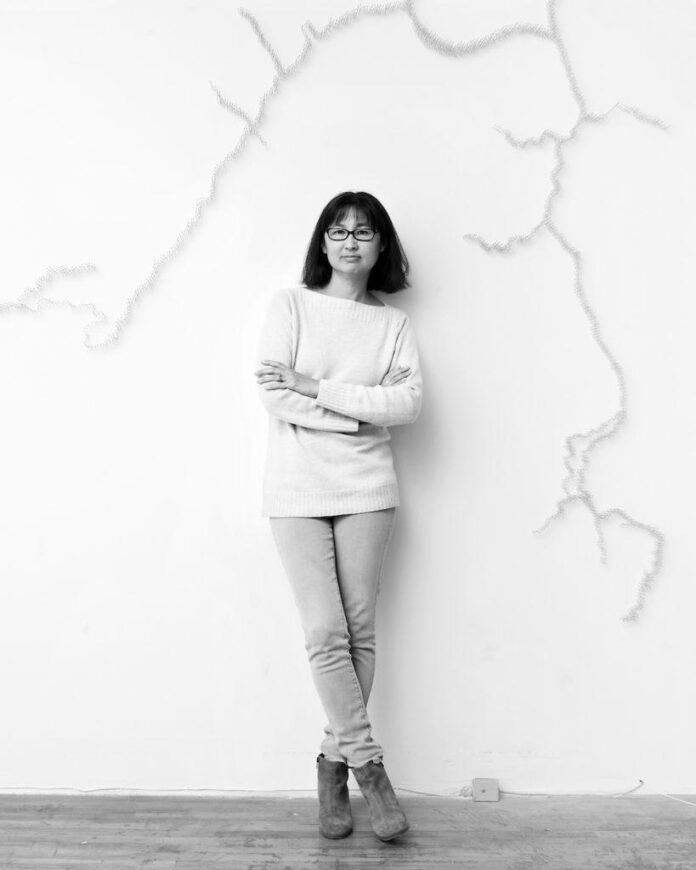In 2021, Maya Lin planted 49 Atlantic white cedar trees, each blighted by saltwater inundation, in Manhattan’s Madison Square Park. Ghost Forest was the name of the project; it was, in typical Lin fashion, part sculpture and part memorial—a symbol of the power of the natural world and a reminder of its precarity in the face of climate calamity.
But while the rest of us were looking up at Lin’s forest, the artist found herself staring down, wondering about the activity of the trees below the soil’s surface. Now, she is going one step further to visualize her trees’ subterranean behavior—and she’s turning to the world of NFTs for the first time to do it.
In June, Lin will release “The Secret Life of Trees,” a series of generative art NFTs that recreate, through complex algorithms, the organic growth patterns of root systems underground.
“When I was creating Ghost Forest, I was thinking about how each tree, through its root structure, begins to communicate with one another,” the artist told Artnet News in an email. “This project stems from that realization of how beneath the soil, tree roots begin to grow and intertwine and communicate with one another, forming a hidden and intricate living interconnected system below the earth’s surface.”

Maya Lin, Three Seed Multi (2023). Photo: © Maya Lin, courtesy of Pace Verso and Art Blocks.
Hosted by Pace Verso—Pace Gallery’s crypto art arm—and minted by the generative art platform Art Blocks, Lin’s NFTs will take the form of little seeds. But they won’t stay that way for long: outgrowing roots will quickly transform the digital artworks into what Lin calls “unique, multi-stemmed organisms of differing colors.”
“I was interested in exploring organic growth patterns in computer-generated works, which tend to be based more on fractal patterning and being much more geometric in aspect,” she said. “I was very keen on exploring a more organic living growth pattern and one that with each seed, will reflect a unique timeframe in which that seed grows. Some will grow quite slowly, encouraging owners to hold on to them and be patient as they grow.”
Lin’s project is one of three Pace Verso plans to release this spring and summer through its ongoing partnership with Art Blocks. The first of the bunch is “PRELUDES,” an experiential NFT series by Trevor Paglen that combines graphic visuals with music inspired by composers like John Cage and Iannis Xenakis, who experimented with algorithms in their own work.
Hidden in Paglen’s digital creations are easter eggs tied to CYCLOPS, his new “speculative reality work” that looks at the history of PsyOps in America. Collectors able to crack the hidden code will be rewarded with a vinyl record related to the project, as well as a gelatin-silver print created by the artist.
Paglen’s “PRELUDES” will be released on April 5, while the rest of CYCLOPS will be revealed a little more than a month later in his dedicated exhibition at Pace’s New York gallery.

Trevor Paglen, “PRELUDES,” Mint #0 of 250 unique NFTs. Photo: © Trevor Paglen, courtesy of Pace Verso
and Art Blocks.
Also on the docket for Pace Verso is a new series of 195 unique NFTs by John Gerrard, each of which depicts a different nation’s flag in a desert setting. Titled “World Flag,” the work relates to the artist’s previous two NFT efforts, including his 2022 project “Petro National,” which was among the first artworks released through Pace Verso’s partnership with Art Blocks.
The gallery has produced roughly half a dozen Art Blocks projects since the collaboration was announced last June. Among them are pieces by Tara Donovan, Loie Hollowell, teamLab, and Robert Whitman.
For these artists—all of whom were new to the world of crypto art when they began their respective projects—generative art and its potential provided the appeal, Pace Verso head Ariel Hudes explained. She called it the “most exciting space within Web3.”
“It’s where the form and the content really meet,” Hudes said. “There’s no reason a JPEG or an MP4 needs to be on the blockchain, whereas generative code can’t exist in quite the same way anywhere else.”
“I truly believe generative art is here to stay and is going to be a tool that many great artists will leverage for a long time to come,” Hudes concluded. “To be at the beginning of that is very exciting.”

























